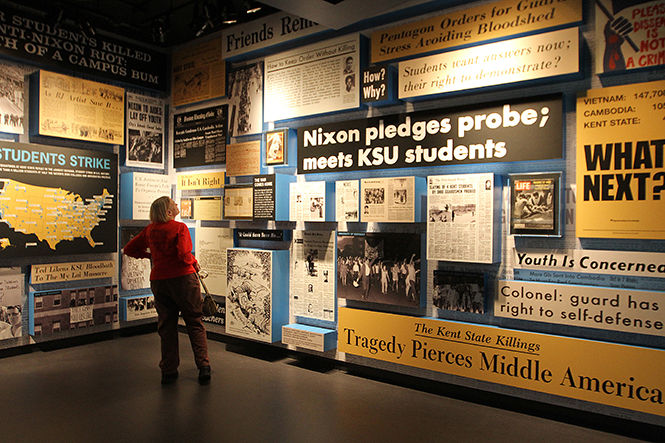The May 4 Visitors Center: A place of understanding and healing
May 3, 2015
In 2012, Kent State opened the May 4 Vistors Center as a way to remember the events of May 4, 1970, and the lives of students Jeffrey Miller, Allison Krause, William Schroeder and Sandra Scheuer who were killed.
“The story has to be available and it wasn’t really available,” said Laura Davis, the founding director of the May 4 Visitors Center. “There’s lots of information in the archives, but it’s of course raw information, it’s primary information. Sometimes secondary information, but it’s not organized into a package where someone can easily spend 45 minutes (with) the basic facts of what happened, how that was a reflection of those times, so ultimately this is where we got to.”
The Visitors Center, located in Taylor Hall, has a multimedia exhibit showing related events going on during the time, including the generation gap, the civil rights movement, the Vietnam War and the division amongst the public surrounding the war.
A second gallery leads visitors into a dimmed room, with maps and a video depicting the protests and shootings, followed by the immediate reaction from the students.
In a third gallery, visitors see the reactions from the rest of the world with excerpts from national and local newspapers — including one from each victim’s hometown — reporting the events at Kent State. The gallery also has a map of university protests from all over the United States and photos of student solidarity.
“This wall is about impact,” Davis said of the third gallery. “And that impact is conveyed subliminally because parts of the wall actually come out to meet you, and you can tell that the story, you know, goes from floor to ceiling. It has to wrap around the side of the wall because the impact was so great, and it was so widespread that the physical space actually tries to convey some of that.”
Neeley Meyers, a graduate public health major, said the center is very informative.
“For someone who’s in college now, it definitely sheds light on the events,” Meyers said.
Both Davis and the current director of the May 4 Visitors Center, Mindy Farmer, said the Visitors Center also became important to the healing process from the events of 1970.
“I think part of the healing is understanding,” Farmer said. “We really try and get an honest account of the facts. Not the interpretations.”
The idea that talking is healing is strongly promoted by the Visitors Center, Farmer said.
“By showing what we know now to be the documentable facts of the experience and recognizing a multiplicity of points of view, I think those elements are respectful of everyone’s experience,” Davis said. “It’s something that people wanted, and it’s a place where they can see that truth is being spoken.”
Farmer said a man who witnessed May 4 took a creative writing class at the Wick Poetry Center and left a poem he wrote there. There was a sense of healing that came with that and having a place to leave a little bit of one’s self, she said.
“(This year) is interesting, because we have to bridge the gap between those who experienced it and those who have an experience of May 4 but it wasn’t as an eyewitness,” Farmer said. “And that’s what’s interesting about this: the coming together of generations and passing on the knowledge and the new legacy of May 4.
Davis said there are many timeless elements of May 4, including remembering the four students who died.
“As human beings we have to acknowledge those who have gone before us and those who we’ve lost. We have to do that or we wouldn’t be human,” Davis said. “If we don’t keep the First Amendment alive, if we don’t keep the democratic principles alive, if we don’t practice civil discourse, what kind of society, what kind of country, what kind of world are we living in?”
Contact Skye McEowen at [email protected].

























